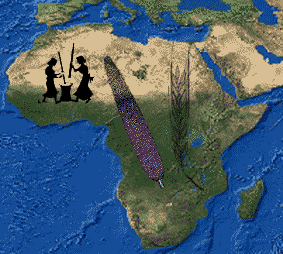|

|
 |

The Fifth International Workshop for African Archaeobotany will
be held 2-5 July, 2006
at the Institute of Archaeology,
University College London. For scheduled papers and absracts select days below.
|
The Fifth International Workshop for African Archaeobotany will
be held 2-5 July, 2006 |
|
|
Monday, 3 July, 2006 Session: Gathered resources: foragers, wood fuels and the environmental impac
ABSTRACT Holocene environmental change and land use at Ounjougou, Mali
Barbara Eichhorn Institut für Archäologische Wissenschaften Archäologie und Archäobotanik Afrikas
The site complex of Ounjougou is situated on the banks of the Yamé river crossing the Dogon Plateau in Mali. It comprises numerous Holocene archaeological sites and natural river deposits which have been investigated during the past decade by an international and multidisciplinary project, focusing on the interrelation between human occupation and environmental variability. A feature unique for West Africa is the excellent preservation of archaeobotanical material in the sediments. This paper first of all presents a synthesis of charcoal analytical data from Ounjougou, reflecting a gradual vegetation change: During the earliest Holocene the presence of a sparsely wooded, open Sahelian savanna seems likely, followed by distinctly denser vegetation types later on. Sudanian savanna forest mosaics with several Guinean elements in the Midholocene are again followed by a more open landscape, probably a Sudanian savanna with Sahelian elements and fewer Guinean taxa mainly confined to the gallery forest. This obviously confirms the generally accepted aridification trend during the late Holocene. Furthermore, the finds of carbonised Pennisetum glaucum caryopses in the site of the “Varves” indicate the practice of agriculture in the region after 3200 BP. An influence of this early cultivation on the woody vegetation is likely, but can up to now hardly be discriminated from climatic causes of vegetation change. Opal phytolith analysis is considered to be an appropriate tool for attaining further ecological information in future, especially on the composition of the grass layer in the savannas. ... return to Monday schedule Tuesday 4 July . . . Wednesday, 5 July, 2006 ....... |
|
Send mail to d.fuller@ucl.ac.uk with questions or
comments about this web site.
|